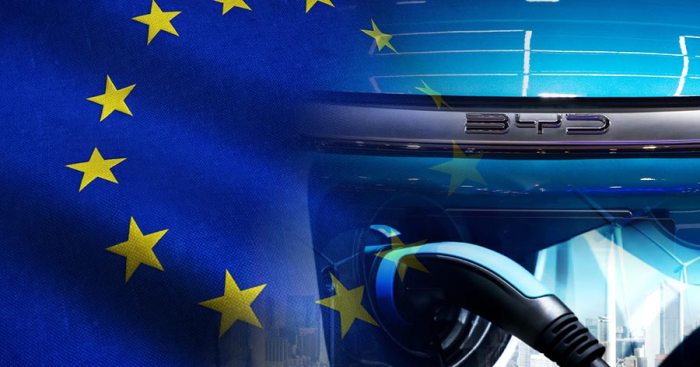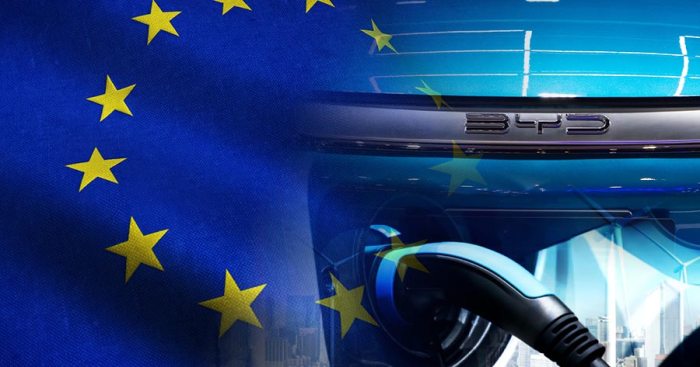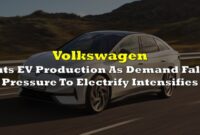EU tariffs on Chinese EVs have sent ripples through the global automotive industry, raising questions about the future of electric vehicle trade and the complex relationship between Europe and China. This move, fueled by concerns over fair competition and potential market dominance, has sparked a debate about the implications for both consumers and manufacturers.
The EU’s decision to impose tariffs on Chinese EVs stems from a desire to protect its domestic automotive industry and ensure a level playing field for European manufacturers. However, the move has also raised concerns about potential price increases for consumers and limited access to affordable EV models.
This complex situation highlights the intricate interplay of economic, political, and technological factors in shaping the future of the global EV market.
EU Tariffs on Chinese Electric Vehicles

The European Union (EU) has recently imposed tariffs on Chinese electric vehicles (EVs), a decision that has significant implications for the European automotive market and the global EV industry. This move is driven by a complex interplay of economic, political, and strategic considerations.
Rationale for the Tariffs
The EU’s decision to impose tariffs on Chinese EVs is rooted in concerns about unfair competition and the potential for Chinese EV manufacturers to gain an unfair advantage in the European market. The EU argues that Chinese EV manufacturers benefit from government subsidies and other forms of support that distort the market and create an uneven playing field.
Impact on the European Automotive Market
The EU tariffs on Chinese EVs are expected to have a significant impact on the European automotive market. The tariffs will make Chinese EVs more expensive for consumers, potentially reducing their appeal. This could lead to a decrease in demand for Chinese EVs, potentially impacting sales and market share.
Impact on the Global EV Industry
The EU’s decision to impose tariffs on Chinese EVs could have broader implications for the global EV industry. It could set a precedent for other countries to impose similar tariffs on Chinese EVs, potentially leading to trade tensions and disrupting global supply chains.
Historical Context of Trade Relations Between the EU and China in the Automotive Sector
The EU and China have a long history of trade relations in the automotive sector. However, the relationship has become increasingly strained in recent years, with both sides accusing each other of unfair trade practices. The EU has raised concerns about China’s support for its domestic EV industry, while China has accused the EU of protectionist policies.
Tariff Details and Impact
The European Union’s (EU) decision to impose tariffs on Chinese electric vehicles (EVs) has sparked significant debate about the implications for both the Chinese EV industry and European consumers. These tariffs, implemented as part of the EU’s broader trade strategy, are designed to protect European EV manufacturers and promote domestic production.
The tariffs, ranging from 10% to 25%, are levied on both imported Chinese EVs and their components, including batteries, motors, and other key parts. This means that Chinese EV manufacturers, such as BYD, Nio, and Xpeng, are facing increased costs when exporting their vehicles to the EU market.
These costs are likely to be passed on to consumers, potentially impacting the price competitiveness of Chinese EVs in Europe.
Discover more by delving into uk chinese cyberattacks large scale espionage campaign further.
Impact on Chinese EV Manufacturers
The EU tariffs have a significant impact on Chinese EV manufacturers.
- Increased production costs: The tariffs directly increase the cost of exporting EVs to the EU, reducing profit margins for Chinese manufacturers.
- Reduced market share: Higher prices due to tariffs may make Chinese EVs less attractive to European consumers, potentially reducing their market share.
- Shifting export strategies: Chinese EV manufacturers may need to adjust their export strategies, potentially focusing on markets outside the EU or exploring alternative manufacturing locations within the EU to avoid tariffs.
Impact on European Consumers
The EU tariffs on Chinese EVs are likely to have a mixed impact on European consumers.
- Increased prices: Consumers may face higher prices for Chinese EVs due to the tariffs, which could make them less affordable.
- Limited choice: If Chinese EV manufacturers are forced to reduce their exports to the EU due to tariffs, European consumers may have a smaller selection of EV models to choose from.
- Potential for innovation: The tariffs could also incentivize European EV manufacturers to innovate and develop more competitive models, potentially benefiting European consumers in the long run.
Economic and Political Implications
The imposition of tariffs on Chinese electric vehicles (EVs) by the EU carries significant economic and political implications for both sides. These tariffs have the potential to disrupt trade flows, impact job creation, and exacerbate existing geopolitical tensions.
Economic Implications for the EU and China
The EU’s tariffs on Chinese EVs are likely to have a mixed impact on the European economy. While they may protect European EV manufacturers from Chinese competition in the short term, they could also lead to higher prices for consumers and potentially hinder the development of the European EV market.
The tariffs could also damage the EU’s relationship with China, which is a major trading partner.
- Trade Imbalances:The tariffs could exacerbate existing trade imbalances between the EU and China. China is already a major exporter of goods to the EU, and the tariffs on EVs could further increase the trade deficit. This could lead to political pressure in the EU to impose further tariffs on Chinese goods, potentially escalating trade tensions.
- Job Creation:The tariffs could have a mixed impact on job creation in the EU. While they may protect jobs in the European EV industry, they could also lead to job losses in other sectors, such as retail and logistics, as consumers are forced to pay higher prices for EVs.
The overall impact on job creation is uncertain and will depend on a number of factors, including the size of the tariffs and the response of the Chinese government.
- Impact on Chinese EV Industry:The EU’s tariffs are likely to have a negative impact on the Chinese EV industry. Chinese EV manufacturers are increasingly looking to export their vehicles to Europe, and the tariffs will make it more difficult and expensive to do so.
This could lead to a slowdown in the growth of the Chinese EV industry, which could have implications for global EV production and supply chains.
Political Ramifications
The tariffs on Chinese EVs are likely to increase tensions between the EU and China. Both sides have accused each other of unfair trade practices, and the tariffs could further escalate this conflict. The tariffs could also have implications for global trade negotiations, as other countries may be hesitant to engage in free trade agreements with the EU or China if they fear similar protectionist measures.
- Geopolitical Tensions:The EU’s tariffs are likely to be seen by China as a protectionist measure aimed at hindering its economic growth and global influence. This could lead to a further deterioration in relations between the two economic blocs, potentially impacting cooperation on other issues, such as climate change and global security.
- Impact on Global Trade Negotiations:The tariffs could also have a negative impact on global trade negotiations. Other countries may be hesitant to engage in free trade agreements with the EU or China if they fear similar protectionist measures. This could lead to a slowdown in the global trade liberalization process and potentially damage the global economy.
- Impact on Global EV Market:The tariffs could have a significant impact on the development of the global EV market. If the EU’s tariffs are successful in protecting European EV manufacturers from Chinese competition, it could lead to a fragmentation of the global EV market, with different regions developing their own EV standards and technologies.
This could hinder the development of a truly global EV market, which is essential for achieving economies of scale and reducing the cost of EVs.
Industry Response and Future Outlook: Eu Tariffs On Chinese Evs
The EU’s decision to impose tariffs on Chinese electric vehicles has triggered a wave of reactions across the automotive industry. Both European and Chinese EV manufacturers have expressed their concerns and Artikeld their strategies to navigate this new trade landscape.
This section will analyze the responses of key players and explore the potential implications for the future of the EU-China relationship in the automotive sector.
Reactions of Key Players
The EU’s tariffs have sparked a range of responses from key players in the automotive industry. European EV manufacturers, such as Volkswagen, Stellantis, and Renault, have expressed concerns about the potential for increased competition from Chinese EV makers, particularly in the lower-priced segment.
These manufacturers have argued that the tariffs could hinder the development of a competitive European EV market and potentially slow down the transition to electric mobility.Chinese EV manufacturers, including BYD, NIO, and Xpeng, have also reacted to the EU’s tariffs.
Some manufacturers have expressed concerns about the impact on their export plans and have indicated that they may need to adjust their pricing strategies or consider alternative markets. Others have argued that the tariffs are unlikely to significantly impact their growth prospects, as they are confident in the long-term competitiveness of their products.
Strategies to Mitigate the Impact of Tariffs
Chinese EV manufacturers are likely to employ a variety of strategies to mitigate the impact of the EU’s tariffs. These strategies may include:
- Adjusting pricing strategies: Some manufacturers may consider increasing prices in the EU market to offset the tariffs, while others may absorb the cost to maintain competitiveness.
- Investing in local production: To avoid tariffs, some Chinese EV manufacturers may explore establishing production facilities in the EU, enabling them to manufacture and sell vehicles locally without incurring import duties.
- Developing alternative markets: Chinese EV manufacturers may focus on expanding their presence in other regions, such as Southeast Asia, Africa, and Latin America, where tariffs may be lower or nonexistent.
- Lobbying for tariff removal: Chinese EV manufacturers may engage in lobbying efforts to persuade the EU to reconsider its tariff policy, highlighting the potential benefits of increased trade and collaboration in the EV sector.
Future Outlook of EU-China Relationship in the Automotive Sector
The EU’s tariffs on Chinese EVs have undoubtedly strained the relationship between the two economic powerhouses in the automotive sector. However, the future outlook is not entirely bleak. There is potential for further trade negotiations and collaboration, particularly in areas where both sides have shared interests, such as:
- Development of common standards: The EU and China could work together to develop harmonized standards for electric vehicles, charging infrastructure, and battery technology, fostering greater interoperability and reducing trade barriers.
- Collaboration on research and development: Both sides could collaborate on research and development projects in areas such as battery technology, autonomous driving, and electric vehicle safety, leveraging their respective strengths and expertise.
- Joint investment in infrastructure: The EU and China could jointly invest in charging infrastructure development, particularly along key trade routes, facilitating the seamless movement of electric vehicles across borders.
The EU-China relationship in the automotive sector is likely to evolve in the coming years, shaped by a complex interplay of economic, political, and technological factors. The success of future trade negotiations and collaborations will depend on the willingness of both sides to find common ground and address their respective concerns.
Comparative Analysis
The introduction of tariffs on Chinese electric vehicles (EVs) by the EU has undoubtedly sparked debate and raised concerns about the competitiveness of Chinese EV manufacturers in the European market. To better understand this dynamic, a comparative analysis of key features and specifications of popular Chinese EVs and their European counterparts is essential.
This analysis aims to provide a comprehensive overview of the competitive landscape for EVs in the European market, considering factors such as pricing, range, battery capacity, performance, and safety features.
Comparison of Key Features and Specifications
A direct comparison of popular Chinese EVs with their European counterparts highlights both similarities and differences in their offerings. This analysis focuses on key features and specifications that are crucial for consumers making purchase decisions.
| Feature | Chinese EV | European EV |
|---|---|---|
| Model | BYD Han EV | Tesla Model 3 |
| Price (starting) | €45,000 | €44,000 |
| Range (WLTP) | 550 km | 490 km |
| Battery Capacity | 85.4 kWh | 75 kWh |
| Performance (0-100 km/h) | 4.7 seconds | 5.6 seconds |
| Safety Features | Autonomous Emergency Braking, Lane Keeping Assist, Blind Spot Monitoring | Autonomous Emergency Braking, Lane Keeping Assist, Blind Spot Monitoring, Adaptive Cruise Control |
The table illustrates that Chinese EVs, such as the BYD Han EV, are increasingly competitive with European counterparts like the Tesla Model 3. They offer comparable features and specifications, including range, battery capacity, and performance, at similar price points.
Competitive Landscape for EVs in the European Market
The European EV market is becoming increasingly competitive, with both established European manufacturers and emerging Chinese players vying for market share. The introduction of tariffs on Chinese EVs is likely to have a significant impact on the competitive landscape.The European market is characterized by strong demand for EVs, driven by government incentives and consumer awareness of environmental concerns.
However, the market is also characterized by a high level of competition, with established European manufacturers such as Volkswagen, BMW, and Daimler already having a strong presence.The entry of Chinese EV manufacturers, with their competitive pricing and advanced technology, has further intensified competition.
The introduction of tariffs is likely to make Chinese EVs less attractive to European consumers, giving European manufacturers a competitive edge.However, it is important to note that Chinese EV manufacturers are not simply price competitors. They are also known for their innovative technology, particularly in battery technology and autonomous driving systems.
This technological advantage could help them remain competitive despite the tariffs.The competitive landscape for EVs in the European market is likely to continue to evolve in the coming years. The introduction of tariffs is just one factor that will shape this evolution.
Other factors, such as consumer preferences, government policies, and technological advancements, will also play a significant role.
Illustrative Examples
To better understand the impact of EU tariffs on Chinese EVs, let’s delve into a specific example of a popular model and analyze its potential consequences in the European market.
The Impact of EU Tariffs on the BYD Atto 3, Eu tariffs on chinese evs
The BYD Atto 3, a compact electric SUV, is a prime example of a Chinese EV that is directly affected by the EU tariffs. This model has garnered significant attention in Europe due to its competitive pricing, spacious interior, and impressive range.The EU tariffs, imposed on Chinese EVs, have resulted in a price increase for the BYD Atto 3 in the European market.
The manufacturer, BYD, has had to adjust its pricing strategy to absorb the added costs associated with the tariffs. This price hike, while not drastic, has made the Atto 3 slightly less attractive compared to its European counterparts.
Potential Impact on BYD’s Sales and Market Share
The price increase resulting from the EU tariffs could potentially impact BYD’s sales and market share in Europe. While the Atto 3 remains a compelling option, the higher price point might deter some budget-conscious consumers. Furthermore, the tariffs could also affect the availability of the Atto 3 in the European market.
BYD might be forced to prioritize other markets where tariffs are not imposed, leading to limited supply in Europe.
The EU tariffs on Chinese EVs could potentially dampen the enthusiasm for the BYD Atto 3 in Europe, leading to a reduction in sales and market share for BYD.
The impact of the tariffs on BYD’s sales and market share will depend on several factors, including consumer sentiment, competition from other EV manufacturers, and BYD’s ability to adapt its pricing and marketing strategies. However, it is clear that the EU tariffs present a significant challenge for Chinese EV manufacturers like BYD seeking to establish a strong presence in the European market.





